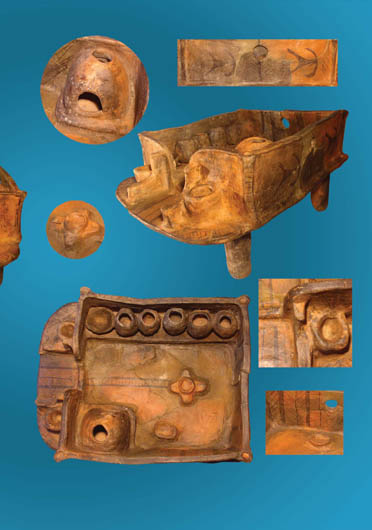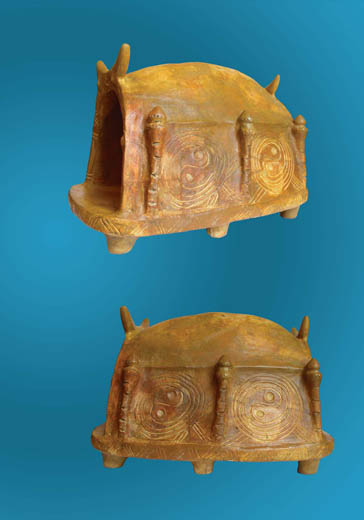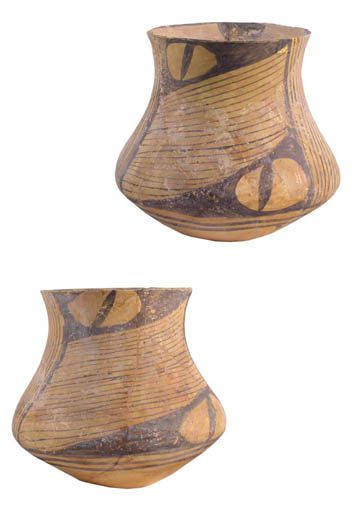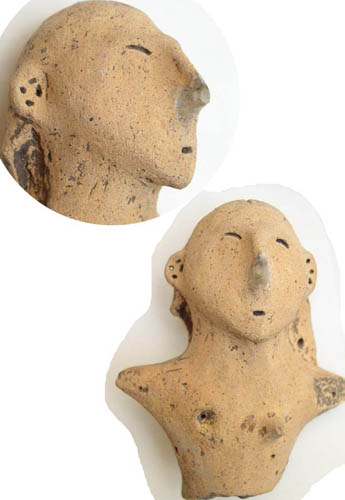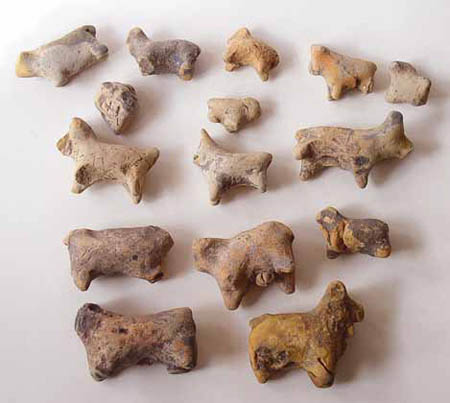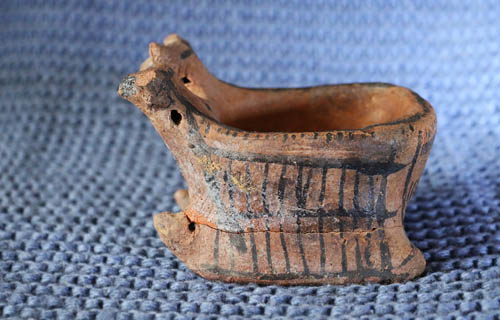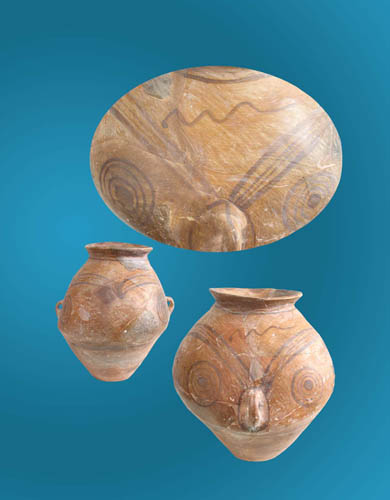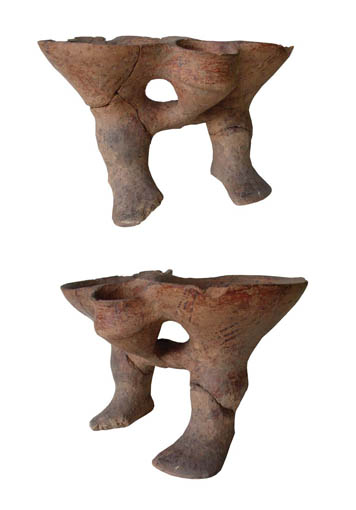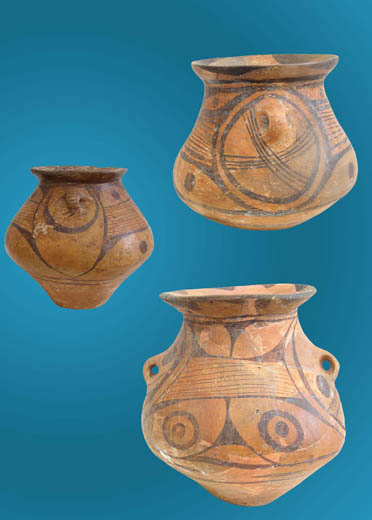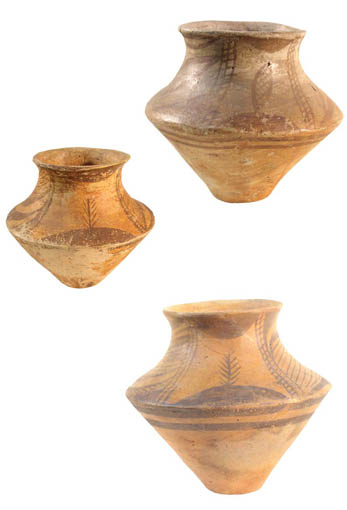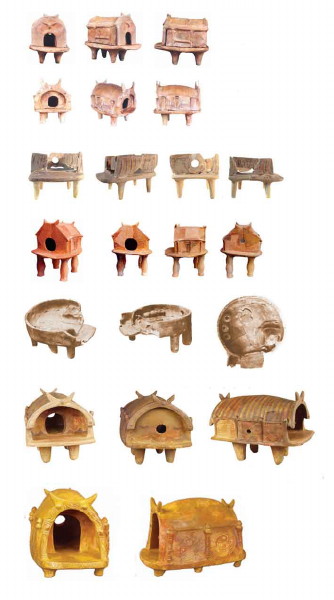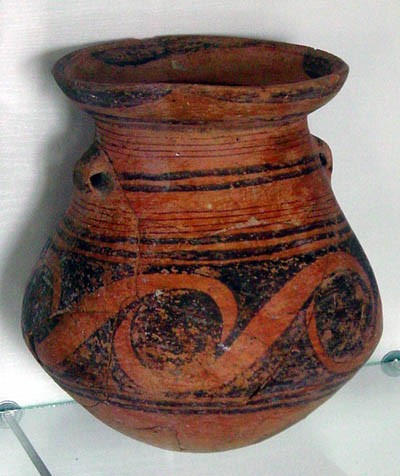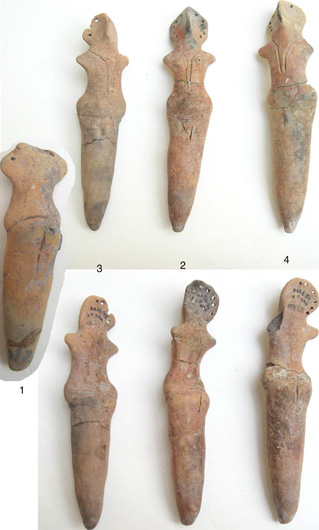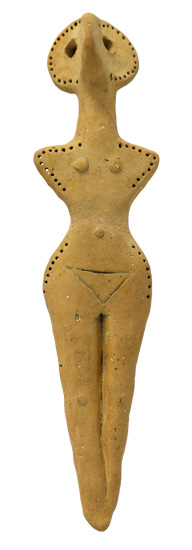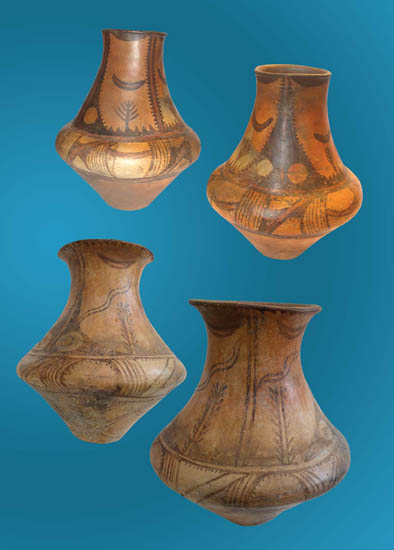Trypillia culture
Trypillia culture or Trypillian culture [Трипільська культура; Trypilska kultura] also known as Cucuteni-Trypillia archeological complex. A Neolithic–Eneolithic–Bronze Age culture that existed on the territory of today’s Ukraine between ca 5000 and 3000 BC. It was named after the village of Trypillia in the Kyiv region, where a large site of this culture was discovered and excavated by Vikentii Khvoika in 1897. However, the history of archeological research of the Trypillia culture sites began considerably earlier, in the second half of the 19th century; first excavations took place in Koshylivtsi and Bilche-Zolote (Verteba Cave) in Galicia, and the culture was referred there at that time as the ‘Galician painted ceramics culture.’ The term ‘Trypillia culture’ became established in 1901, while in the 1920s another name—‘the Ukrainian painted ceramics culture’—was also used.
The Trypillia culture is a component of a broader Ariushd-Precucuteni-Cucuteni-Trypillia (APCT) cultural complex, which extended over a vast territory from Transylvania in the west to the left bank of the Dnipro River in the east. On the territory of Romania, the sites of this cultural complex correspond to the cultures of Precucuteni, Cucuteni, and Horodiştea-Erbiceni. The archeological sites of the Trypillia culture proper are found on the territory of Moldova and, in greatest numbers, in Ukraine. In total, as of 2020, more than 4,800 APCT sites have been discovered, about 2,300 of which are located on the Ukrainian territory.
Periodization. Currently scholars identify three main periods in the development of the Trypillia culture—early or Trypillia A (ca 5000–4600 BC), corresponding to the Precucuteni culture in Romania; middle or Trypillia BI, BI–II, BII, CI (ca 4600–3500 BC), corresponding to the Cucuteni A, AB, B; and late or Trypillia CII (ca 3500–3000 BC), corresponding to the Horodiştea-Erbiceni culture. This periodization is based on the stratigraphy of archeological sites and the types of Trypillian pottery found there. The types of pottery also reflect local cultural differences and specific characteristics of various Trypillian tribal groups.
Origins. The population of the Trypillia culture (henceforth referred to as the Trypillians) belonged to the general cultural and economic type of Neolithic and Eneolithic farmers residing in the foothills, forests of the temperate zone, and/or forest-steppe. A number of Neolithic cultures of central and southeastern Europe were involved in the processes of formation of the APKT cultural complex, which took place around 5000 BC on the territories between the Carpathian Mountains and the Dnister River. These cultures included: the Linear Pottery culture (LBK), Boian culture (also known as the Giuleşti–Mariţa culture or Mariţa culture), Criş culture (of the Starčevo–Körös–Criş cultural complex), Tisza culture, Vinča culture (Vinča-Turda culture), and Hamangia culture. The origins of these cultures, in turn, can be traced to the farmers of Anatolia, who migrated to Europe in the 7th and early 6th millennium BC. Archaeogenetic studies of Trypillia culture human remains have revealed that, in addition to the Anatolian farmer-related ancestry, the Trypillian population harbored Balkan hunter-gatherer related ancestry from the Iron Gates area, going back to the Mesolithic Period, as well as a contribution from the people originating in the North Caucasus and the Lower Volga area.
Expansion. Having been formed in the foothills of the Carpathian Mountains, the Trypillia culture gradually spread to the east and reached the Dnipro River Valley around 4300 BC; later, after 3800 BC, it crossed over to the left bank of the Dnipro. At that stage of the culture’s evolution, the most densely populated Trypillian regions were the areas along the Dnister River, Podilia, and the territories between the Boh River and Dnipro River, which encompassed the forest zone in the west and the forest-steppe belt in the east. The primary reason for the eastward expansion of the Trypillian communities was the rapid population growth in the western territories between 4600 and 4000 BC, reflected in the significant increase in the number of settlements in that region: from 200–300 during the Trypillia A period to over 1000 during the Trypillia BI, BI–II, and BII periods. According to some estimates, the total Trypillian population around 4000 BC may have exceeded 400,000.
During the period after ca 4600 BC there arose various local groups and tribes within the overall complex of the Trypillia culture. On the Ukrainian territory alone, scholars distinguish about 70 such distinctive groups that existed during the period between 4600 and 3000 BC. Thus, over this time span of more than 1,500 years, the Trypillia culture did not comprise a monolithic cultural entity, but was a diverse conglomerate of many separate tribes that were, judging by their population numbers, most likely united in several supra-tribal social formations of the chiefdom type.
Settlements and Dwellings. The majority of early Trypillian settlements were situated on banks of rivers and streams. In addition to permanent settlements, there were temporary camps, also tied to rivers. The most ancient Trypillian villages consisted of anywhere from one to several dozen above-ground dwellings of various sizes. The largest known early Trypillian settlement, Mohylna-3, situated on a tributary of the Boh River, had about one hundred houses. Some villages were fortified with ditches and palisades. The buildings were either one or two storeys high, rectangular, of frame construction, with walls, inter floors, and attic floors plastered with clay that was mixed with straw or other organic substance. This type of building construction was predominant throughout the entire span of the Trypillia culture’s existence.
In two-storey buildings, the second floor served, as a rule, as a residential space. It contained an open hearth or dome stove near the door and a low clay ledge along the longer wall. Large unfired pottery vessels, made out of a mixture of clay and chaff and decorated with painted and incised ornaments, were placed on this ledge and used for storing grain. Earthenware troughs with grain graters embedded in them were arranged near the stove. A round or cross-shaped altar was situated in the back of the room under a single round window in the wall opposite the entrance. Such altars were found in settlements belonging to the Trypillia culture’s middle period (ca 4600–3500 BC), such as the Volodymyrivka Trypillian megasite, Maidanetske Trypillian megasite, Talianky Trypillian megasite, Nebelivka Trypillian megasite, and others. The doorway was furnished with a wooden door and a clay threshold; stone supports for the door were found in some instances. The attic floor contributed to keeping the room warm. The building’s first storey was utilized for various household needs, such as storing farming equipment and other supplies.
In the vicinity of Trypillian buildings pits of various sizes were excavated. These pits served a variety of purposes. Some of them were formed after clay was extracted for the construction or repair of buildings. Such pits, especially after they were filled with archeological remains, were once interpreted by some scholars as remnants of ‘pit-dwellings’ or ‘semi-pit dwellings,’ even though they do not have flat floors or the requisite type of interiors. Sometimes these pits were used to ‘bury’ the debris of houses that possibly had been burned down during ritual ceremonies. Anthropomorphic and zoomorphic ceramic figurines, most often fragmented, were also found in such pits, suggesting some sort of ritualistic activity.
Proto-cities. After 4300 BC in addition to numerous ordinary settlements, Trypillian megasites or proto-cities appeared. These conglomerations—exceptionally large for this prehistoric epoch—extended over the area from 50 ha to 200 ha or even more and could house some 5,000 to 15,000 inhabitants at any one time. Each of the local chiefdom groups (except two that were situated along the Dnipro River) had a political center of such type. The largest known proto-cities, located in the region between the Boh River and Dnipro River, were the Volodymyrivka Trypilllian megasite, Kosenivka Trypilllian megasite (ca 70 ha), Sushkivka Trypilllian megasite (over 100 ha), Dobrovody Trypilllian megasite, Maidanetske Trypilllian megasite, Nebelivka Trypilllian megasite (over 200 ha), and Talіanky Trypilllian megasite (about 340 ha). The largest settlements between the Dnister River and Boh River were the Bilyi Kamin Trypilllian megasite (97 ha), Yaltushkiv Trypilllian megasite (55 ha) and Chechelnyk Trypilllian megasite (56.5 ha).
The building distribution density at these megasites varied considerably: for example, on an area of roughly the same size, some 3,000 buildings were found in the Maidanetske Trypillian megasite, and only about 1,500 in the Nebelivka Trypillian megasite. These proto-cities existed, on average, from 100 to 150–200 years before they were ritualistically burned down by their inhabitants who then moved to new locations. Some of the megasites (Maidanetske, Nebelivka) had extensive fortifications in the form of palisades. Larger public buildings and/or temples were detected in these settlements through magnetic surveying and some of them were later excavated and studied. Currently, more than one hundred of such structures are known within the overall complex of Trypillia culture. The largest of the excavated temples is the Nebelivka temple. It measured 20 x 60 m and was the central temple of the megasite. In addition to it, smaller religious/public buildings were also found there, ranging in size from 200 to 500 sq m. Remains of similar public building or temples, with an area of up to 300 sq m, were also excavated in the Maidanetske Trypillian megasite. Remnants of two-tier pottery kilns, including multi-channel ones, were also found at the sites of these proto-cities, testifying to the existence of specialized craft centers that manufactured painted pottery.
Economy
Agriculture and animal husbandry formed the basis of the Trypillian economy. Surplus food production stimulated the emergence of organized crafts—metallurgy, metalworking, flint processing, pottery making, and possibly weaving. A system of exchange of food resources for crafted goods developed and it extended not only within the Trypillian areas of settlement, but also to the lands of neighboring tribes and cultures.
Food production
Agriculture. The Trypillians used both hand tools (hoes) and plowing tools (wooden ploughs) for land cultivation. Wooden ploughs were drawn by oxen, as is indicated by the excavated skeletal remains of oxen with characteristic bone pathologies. It has been established that the Trypillians used organic fertilizers to enhance crop growth on their fields. The fact that, in addition to cereals (wheat, oats, barley), they also cultivated legumes (peas, ervil), indicates the probability of crop rotation. Crops were harvested using sickles with flint inserts. In the early period and at the beginning of the middle period, sickles were furnished with several such inserts, made of small pieces of flint; during later periods, these were replaced by single large serrated blades (up to 20 cm long), similar to modern iron sickles. Grain was processed on grain grinders; each dwelling contained from 1–2 to 5 or even more of such grinders. Multiform incisions in the stones of such grinders made it possible to obtain either flour for bread, or groats for porridge. As for technical crops, Trypillians are known to have cultivated flax.
Animal husbandry. Depending on local conditions, various types of animal husbandry were developed in different regions: meat (along the Dnister River, in Podilia, along the Dnipro River, and in Volhynia) and possibly dairy (in the region between the Boh River and Dnipro River). Seasonal settlements were established for animal grazing, particularly in the Dnipro region. As indicated by the study of the diet of pigs and cattle (based on materials from the Maidanetske and Kosenivka Trypillian megasites), Trypillians fed their animals grain. During the early period, more than fifty percent of the meat for human consumption was obtained from hunting. During later periods, traces of meat from hunted animals were found primarily in seasonal settlements. Trypillians who lived along the Dnister River, Boh River, and Dnipro River engaged in fishing, and the Trypillian population in general by and large collected wild plants for consumption and possibly medicinal use as well.
Horses, possibly domesticated, are known from the early periods of the Trypillia culture. Some of the skeletal horse remains from the middle period suggest that horses may have been used as pack animals. Similar bone pathologies indicate that the Trypillians used oxen as draft animals. Ceramic sculptures of transport sledges were found, with protrusions in the form of ox heads. Other archeological artefacts include ceramic models of wheels, zoomorphic figures, and vessels on wheels, dating to the period between 4000 BC and 3800 BC. However, no archeological evidence for the actual use of wheeled transport by the Trypillians has so far been discovered.
Crafts
Surplus food production allowed for the emergence and development of crafts—metallurgy, metalworking, flint processing, pottery making, and possibly weaving. Trypillians made their tools and weapons out of copper, hard types of stone, bone, and flint. They perfected various techniques of processing hard and soft types of stone, which allowed them to manufacture wedge shaped axes, stone axe-hammers, horseman’s picks, and heads for maces.
Flint processing. Flint was used by the Trypillians to produce inserts for sickles, various scrapers for working with the leather, knives, drills, as well as tips for arrows, darts, and spears. The flint processing technology evolved gradually. For example, the sizes of flint nuclei—chips for the manufacture of blades—increased from 5–8 cm during the period between 5000 and 4500 BC to 20 cm and more by the end of the 5th millennium BC. The Trypillians invented a mechanism with a lever and parts made of copper for pressing such flint blades. This enabled them to make better and more precise tools. They also began using copper hammerstones—instead of the ones made of antler or wood—to manufacture flint tools, which allowed them to produce more efficient tools for harvesting: the aforementioned serrated sickle inserts.
Flint processing was initially a household craft, practiced by each individual family, but in the second half of the 5th millennium BC it evolved into a specialized craft. Most likely, the flint-processing settlements located near flint deposits functioned seasonally. Their specialized line of work depended on the properties of raw materials in a given area. For example, tools for working with wood—axes, chisels, adzes—were made primarily from gray flint that could be found near mineshafts at Bila Hora on the Dnister River and neighboring territories. On the other hand, at the Bodaky settlement in the Horyn River Valley in Volhynia large plates were mass-produced from ‘Volynian’ flint, which were later processed into tips for darts and spears. In both cases, the production scale significantly exceeded the actual needs of the communities engaged in this work. Thus, we can assume that flint was produced there to be exchanged for other goods.
Weaving. Weaving was introduced in the middle period of the Trypillia culture. Trypillians made use of a vertical loom (similar to the devices used during the times of antiquity and in the early Middle Ages). Fabrics were made from plant fibers (linen or nettle) and wool. The base cloth was stretched on looms by using ceramic weights of different sizes and weights; the width of such base cloth could extend to 1 m or more. Imprints of thin fabrics (at times featuring woven patterns), thick textiles, and fabrics knitted with knitting needles or crochet hooks were found on pottery. Thin bone needles were also excavated, which were used for sewing clothes and textile as well as leather footwear. Images painted on pottery dishes and anthropomorphic figurines provide us with an idea about the style and ornamentation of Trypillian clothes.
Pottery making. Pottery production evolved gradually from a domestic pursuit in the early period and the beginning of the middle period to a specialized craft, starting from the second half of the 5th millennium BC. This transition was induced by the spread and advancement of painted pottery making techniques that originated in the region of the Cucuteni culture. The craft of pottery making required a requisite knowledge of clays and of the processes of preparing molding masses by mixing various clay varieties and adding other admixtures. Paints were prepared using organic solvents that were resistant to high-temperature firing with hot air that was performed in two-tier furnaces, including multi-channel ones. These Trypillian furnaces represent, as of today, the oldest thermal engineering devices of their type found anywhere in Europe. With time, the making of painted ceramic ware turned into mass production. On the territory of some of the proto-cities traces of several dozen (in the Petren Trypillian megasite, Maidanetske Trypillian megasite, and Dobrovody Trypillian megasite) to a hundred or more (in the Talianky Trypillian megasite) large pottery furnaces were discovered.
During the early period, pottery was decorated with carved and stamped ornaments, which were inlaid with white or red paste; the spaces between the ornaments were usually colored with red paint. The traditions of creating such carved decorations were preserved throughout the entire period of the Trypillia culture’s existence, however, after 4600–4500 BC pottery of that type was made mainly in the eastern territories of the Dnipro region; on the territories further west painted ceramic ware was predominant. The painted decor was applied on the ceramic ware either with one paint (monochrome painting), or two (bichrome painting), or three (polychrome painting). The colors used were white, red, shades of brown (from dark to light), and black. Paint was applied on engobe—a clay slurry that covered the pottery and could be of various colors: reddish, orange, white, or other—which formed the background for the painted ornament. The colors of painted pottery and their various combinations, all of which had symbolic meanings, in conjunction with characteristic stylistic features and typical ornamental patterns can be used to identify cultural traditions of distinct Trypillian tribes and tribal alliances.
From its earliest stages, the Trypillia culture produced a great variety of forms of ceramic vessels and dishes. For the early period, about a dozen of different varieties of ceramics are known (pots, bowls, cups, jars, pear-shaped vessels with lids, and others), while for the middle period, the number of various pottery types increased to almost twenty. Also differentiated by size, these distinct varieties of ceramics made up a diversified array of objects that served miscellaneous specialized functions both in domestic life and in the sphere of religious ritual (for example, double ‘binocular-type’ containers, pottery with zoomorphic projections, and anthropomorphic or zoomorphic vessels). This rich variety of masterfully produced ceramic ware clearly reflects a high level of sophistication of the Trypillians’ daily life, as well as the complexity of their religious and spiritual activities. It also testifies to the establishment and growth of what one could call a luxury goods economy.
Metallurgy and metalworking. A large number of products made of copper (hundreds of such objects are known today) appear in Trypillian settlements as early as the first half of the 5th millennium BC. Their assortment ranged from tools (axe heads, prickers, and awls) and weapons (axe-hammers) to jewelry (ornaments that were sewn onto clothing, bracelets, rings, and necklace beads). The origin of copper, the processing technology, and the type of metal objects found in Trypillian settlements suggest that these objects were produced in southeastern and central Europe. At the same time, the finds of ore crushers, raw metal pieces, and copper-processing tools indicate that copper objects were also manufactured locally. Trypillian artisans were familiar with such metalworking technologies as casting into simple and complex forms, blacksmithing (including copper welding), and tempering.
After 4500 BC Trypillian metalworkers began to use local deposits of copper ores in Podilia and copper concentrates from Volhynia. New centers of metalworking appeared along the Dnipro River, where foundry molds, pouring ladles, and finished copper products have been excavated. At that time, the production and use of metal tools and weapons became a mass phenomenon. In fact, without the use of metal tools flint processing could not have developed properly and it would have been impossible, for example, to produce and repair serrated sickles for agriculture, which required periodic retouching to remain sharp. Metal blades used for cutting bone and antler appeared at that time in significant numbers; traces of their incisions have been found on many finished artefacts. Archeologists have also discovered many wedge-shaped copper axes whose shape influenced the forms of axes that were produced out of flint and stone. Already around 4000 BC bladed weapons (daggers) appeared and battle axe-horseman’s picks became widespread (several hundreds of such weapons have been found).
Trade and exchange. Trypillians engaged in extensive trade and exchange within the overall settlement area of the Trypillia culture, trading primarily in raw materials (metal, stone, and flint) as well as in metal and flint products. Large quantities of flint objects originating from the flint-processing centers along the Dnister River and in Volhynia reached not only Podilia, but also as far as the Dnipro River. Painted ceramic ware was ‘imported’ from western Trypillian territories to settlements in the Dnipro region. Some of such ‘imported’ ceramics, found outside of the settlement areas of the local groups that produced them, may likely have been ritual gifts that were exchanged between various tribes, as was characteristic for many prehistoric societies.
External trade and exchange were also of considerable importance. During the early periods, such external trade provided Trypillians with copper and copper goods both from the Balkans (the Karanovo-Gumelniţa culture) and from Transylvania (the Vinča, Tiszapolgár, and Bodrogkeresztúr cultures). Of particular significance was the exchange of raw materials, especially various types of stone, which were traded between the Trypillians and the commuities of the Balkans, Anatolia, and even Egypt. For example, a pendant, found in the Nebelivka temple was made of Anatolian electrum. Trade in salt, including salt from the Carpathian Mountains and the Sea of Azov region, played a crucial role in such external trade and exchange relations. During later periods, Trypillian painted pottery was in great demand in regions outside of the Trypillian areas of settlement.
Spiritual Culture. The existence of a structured and highly evolved spiritual culture among the Trypillians can be surmised not only from the archeological finds of religious/public buildings, such as the Nebelivka temple—the construction and upkeep of which required very considerable effort and material resources—but also from numerous discoveries of ceramic artefacts that were clearly related to the ritual sphere. Apart from the aforementioned ritualistic ceramic ware, archeologists found many anthropomorphic and zoomorphic figurines as well as various amulets. Clay figurines were used in large numbers during various rituals, including sacrificial ones; they were often broken into parts and then ‘buried.’ In the domain of religious symbolism, ornamental compositions on Trypillian pottery seem to reflect the concepts of infinity as well as the eternity and fluidity of life. Overall, the Trypillian system of signs and symbols can be considered to represent a pictographic script intended primarily for the communication with ‘higher forces.’
Trypilians inherited their religious system from the Neolithic cultures of ‘Old Europe,’ whose beliefs, in turn, were rooted in the spiritual traditions of the ancient farmers of Anatolia. After all, it was from Anatolia that the ancestors of ‘Old Europeans’ had once migrated into Europe. For example, the Trypillian rituals of burning houses and entire settlements and periodically moving to new areas was linked to that ancient Anatolian belief system. The main deity in this prehistoric religion was the Great Goddess—Great Mother—who was venerated by the Trypillians alongside with other divine figures, both female and male. The Moon was a physical incarnation of the Goddess, and its phases were depicted on Trypillian pottery throughout the entire history of this culture. The finds of human burials, albeit very rare, as well as numerous examples of realistic ceramic figurines seem to indicate the existence of ancestor worship among the Trypillians.
Social System. Archeological finds suggest the existence of distinct tribes within the Trypillia cultural complex already in the early period (5000–4600 BC). From the middle period (4600–3500 BC) we find indications that these tribes formed coalitions or alliances that might be referred to as chiefdoms. The presence of fortified settlements and a large number of finds of weapons and symbols of power—most notably, battle axes—testify to the importance of warriors in the Trypillian society from the beginning of Trypillian settlement on the territory of today’s Ukraine. By all indications, Trypillians not only successfully defended themselves against various neighboring tribes, but also fought among themselves, creating in the process large-scale supra-tribal coalitions to expand their military power. In the second half of the 5th millennium BC, this led to the emergence of proto-cities, where the majority of the population of a given tribal alliance was concentrated. Trypillian proto-cities represented the economic, military, political, and religious centers of distinct chiefdoms and their role was to ensure the safety and survival of their communities. The epoch of the proto-cities lasted for several hundred years and ended after 3500–3300 BC as a result of the collapse of the Trypillian agricultural economy due to a combination of factors, including major climate changes at the end of the 4th millennium BC.
Historical Fate. The economic crisis of the Trypillia culture at the end of the 4th millennium BC resulted in a sharp population decline. According to estimates based on the number of Trypillian settlements, the population in the Trypillian areas of settlement decreased fourfold after 3500 BC compared to the earlier period. Some scholars suggest that, apart from the climate and economic factors, the rapid decline of the Trypillian population was also caused by a plague (Yersinia pestis) that may have originated in the densely populated Trypillian megasites. A further reorientation of their economy—from one primarily based on agriculture to one focused on animal breeding and hunting—led to the dispersal of the Trypillian population into small communities situated mainly in the forest belt, where resources for survival were still available. This development accelerated the processes of assimilation of the Trypillians living in the forest zone into the communities of the Funnel Beaker culture, and later of the Globular Amphora culture. Those Trypillian enclaves remaining in the forest-steppe area were likely absorbed by the expanding populations of the Yamna archeological culture complex. This, in turn, led to significant transformations in their material and spiritual culture: the traditions and techniques of producing painted pottery were lost and the sphere of ritual life underwent essential modifications (e.g., the rite of burning houses was abandoned, ceramic figurines disappeared, and the system of symbolic signs and ornamentation was greatly simplified). As a result of that, the culture as a whole radically changed, which has been interpreted by many scholars as the ‘disappearance of the Trypillia culture.’ This part of the history of the Trypillia culture stands near the origins of the formation of Corded Ware culture that arose in the region of the middle Dnipro River in the early Bronze Age.
Another part of the Trypillian population—that migrated into the steppes of today’s southwest Ukraine—contributed to the formation of the Usatove culture that engaged in nomadic livestock breeding and salt gathering and exchange. The Usatove-related groups of the northwest Pontic region had a significant impact on the emergence and consolidation of the Yamna archeological culture complex.
BIBLIOGRAPHY
Videiko, M.; Burdo, N.; Liashko, S. (eds). Entsyklopediia trypils'koï kul'tury (Kyiv 2004)
Ciuk, Krzysztof (Ed). Mysteries of Ancient Ukraine: The Remarkable Trypilian Culture, 5400–2700 BC (Toronto 2009)
Videiko, Mykhailo. Ukraine: from Trypillia to Rus (Kyiv 2010)
Burdo, Nаtalia. ‘In Search of the “Sacred Code” of Trypillians,’ in Ancient Trypillia (Kyiv–New York 2010)
Burdo, Natalia. ‘Anthropomorphic plastic art of Trypillia culture: Dialectic of similarities and differences,’ in Studies into South-East European Prehistory, Karl A. Romstorfer (ed.) (Suceava 2014)
Müller, Johannes; Rassmann, Knut; Videiko, Mykhailo (eds). Trypillia Mega-Sites and European Prehistory, 4100–3400 BCE (London–New York 2016)
Rud, Vitalii et al. ‘Trypillia Megasites West of the River Southern Buh: Preliminary Results of Bilyi Kamin Site Investigation in 2018,’ Journal of Neolithic Archaeology 21 (2019)
Makarewicz, Cheryl A. et al. ‘Community negotiation and pasture partitioning at the Trypillia settlement of Maidanetske,’ Antiquity 96 (388) (2022)
Schlütz, Frank et al. ‘Isotopes prove advanced, integral crop production, and stockbreeding strategies nourished Trypillia mega-populations,’ PNAS 120 (52) (2023)
Videiko, Mykhailo. Podorozhi do trypil's'koho svitu (Lviv 2023)
Kirleis, Wiebke et al. ‘A complex subsistence regime revealed for Cucuteni–Trypillia sites in Chalcolithic eastern Europe based on new and old macrobotanical data,’ Vegetation History and Archaeobotany 33 (2023)
Kiosak, Dmytro et al. ‘The chronology of the Early Trypillian expansion,’ Radiocarbon 1–14 (2024)
Mykhailo Videiko
[This article was written in 2024.]

.jpg)
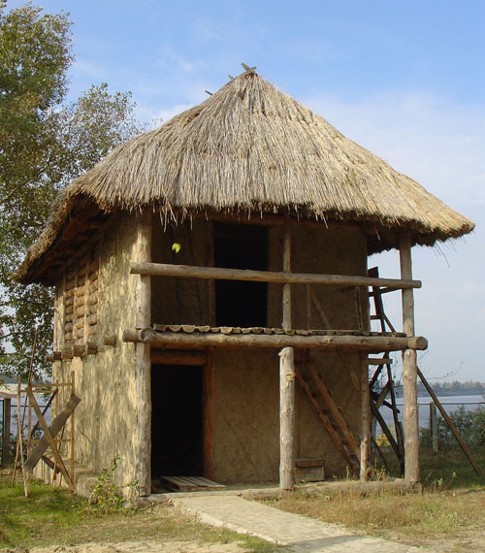
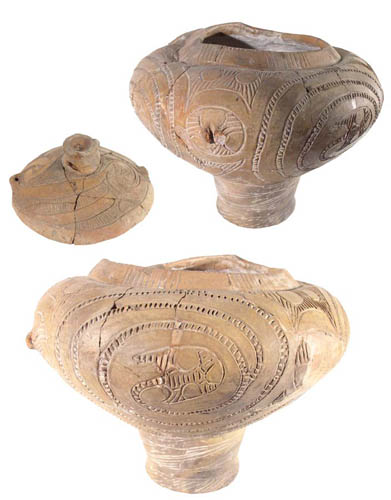
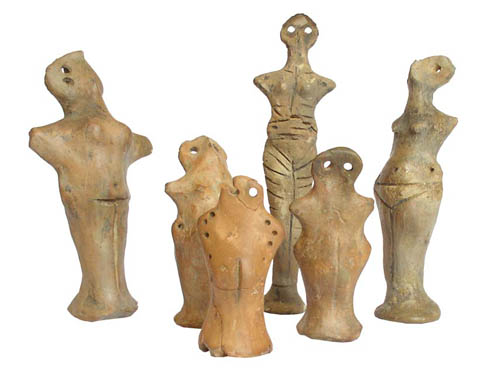
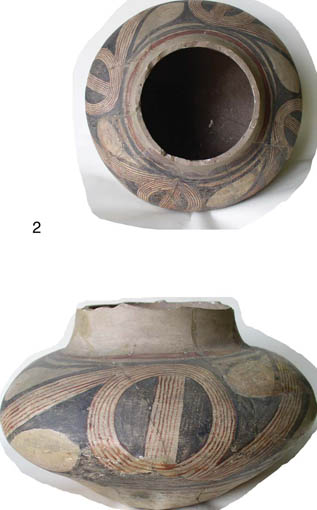
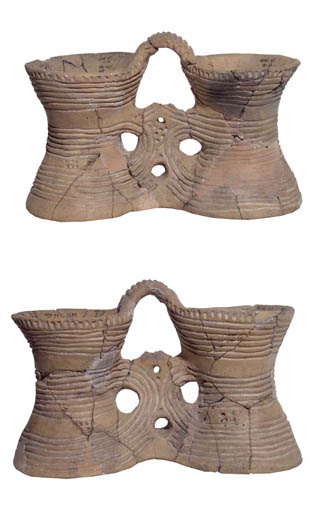
.jpg)
